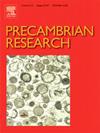Geochronology of the Vindhyan Supergroup: Implications for the closure of the Proterozoic basins of India
IF 3.2
2区 地球科学
Q2 GEOSCIENCES, MULTIDISCIPLINARY
引用次数: 0
Abstract
The sediments of the Vindhyan Supergroup, deposited in the largest Proterozoic basin of India, are known to have recorded changes in the seawater chemistry, changes in global climate, and one of the earliest fossil records of multicellular eukaryotes. These rocks, particularly the upper part of the sequence, are also home to some of the most controversial fossils of the Neoproterozoic lifeforms. Despite receiving enough attention, the evolutionary timeline of the upper part of the supergroup and the timing of the closure of the Vindhyan Basin remained uncertain. Issues related to the stratigraphic correlation within the basin, temporal relation with other Proterozoic basins of India, and validity of the evidence of global events reported from the basin remained unresolved. Here, we present results of Pb-Pb dating of carbonate formations and detrital zircon U-Pb dating of sandstone formations of the upper Vindhyans from the western and the eastern sectors of the basin to resolve some of the above chronological issues. Based on Pb-Pb isochron ages, we establish that the Bhander Limestone formation in the Son Valley sector (eastern) was deposited in two major periods: one at 874 ± 77 (2σ) Ma and the other at 768 ± 36 (2σ) Ma, with breaks in sedimentation in between. Based on the Pb-Pb isochron age of 871 ± 78 (2 σ) Ma, the Balwan Limestone, the topmost carbonate formation in the Rajasthan sector (western), is proposed to be laterally correlatable to the Bhander Limestone in the Son Valley. The Lakheri Limestone formation in Rajasthan is deemed to have no correlatable carbonate formation in the Son Valley. The maximum depositional ages of sandstone formations, determined from zircon U-Pb data, suggest that the top part of the Vindhyan Supergroup is younger than 830 Ma. Our results establish that the closure of the Vindhyan Basin happened sometime during the late Tonian. Therefore, these successions are unlikely to contain evidence of the Cryogenian glaciations or the Ediacaran life. This new age information puts the Vindhyan Basin in the league of at least two other Proterozoic basins of India (i.e., Marwar and Kaladgi), which, contrary to general belief, had remained active during the Neoproterozoic (< 1000 Ma). We did not find any evidence of coevolution of the Vindhyan Basin with other Proterozoic basins of India.
温德扬超群的年代学:对印度元古代盆地闭合的启示
Vindhyan超群沉积在印度最大的元古代盆地,记录了海水化学变化和全球气候变化,是最早的多细胞真核生物化石记录之一。这些岩石,特别是序列的上部,也是一些最具争议的新元古代生命形式化石的所在地。尽管得到了足够的关注,但超群上部的演化时间和Vindhyan盆地的关闭时间仍然不确定。盆地内的地层对比、与印度其他元古代盆地的时间关系以及从盆地报告的全球事件证据的有效性等问题仍未得到解决。本文通过对盆地西段和东段上温德亚统碳酸盐岩地层Pb-Pb定年和碎屑锆石U-Pb定年的研究,解决了上述年代学问题。根据Pb-Pb等时线年龄,确定了东部Son Valley段Bhander灰岩组在874±77 (2σ) Ma和768±36 (2σ) Ma两个主要时期沉积,其间有断裂。根据Pb-Pb等时线年龄(871±78 (2 σ) Ma),认为拉贾斯坦地区(西部)最上层的巴湾灰岩与Son Valley的Bhander灰岩具有横向相关性。拉贾斯坦邦的Lakheri灰岩地层被认为与Son河谷的碳酸盐岩地层没有可比性。根据锆石U-Pb资料测定的砂岩地层最大沉积年龄表明,温德扬超群顶部小于830 Ma。研究结果表明,温德扬盆地的闭合发生在晚托尼世。因此,这些序列不太可能包含冰川期或埃迪卡拉纪生命的证据。这一新时代的信息使Vindhyan盆地与印度至少另外两个元古代盆地(即Marwar和Kaladgi)在一起,这两个盆地与一般的看法相反,在新元古代(<;1000毫安)。我们没有发现Vindhyan盆地与印度其他元古代盆地共同演化的证据。
本文章由计算机程序翻译,如有差异,请以英文原文为准。
求助全文
约1分钟内获得全文
求助全文
来源期刊

Precambrian Research
地学-地球科学综合
CiteScore
7.20
自引率
28.90%
发文量
325
审稿时长
12 months
期刊介绍:
Precambrian Research publishes studies on all aspects of the early stages of the composition, structure and evolution of the Earth and its planetary neighbours. With a focus on process-oriented and comparative studies, it covers, but is not restricted to, subjects such as:
(1) Chemical, biological, biochemical and cosmochemical evolution; the origin of life; the evolution of the oceans and atmosphere; the early fossil record; palaeobiology;
(2) Geochronology and isotope and elemental geochemistry;
(3) Precambrian mineral deposits;
(4) Geophysical aspects of the early Earth and Precambrian terrains;
(5) Nature, formation and evolution of the Precambrian lithosphere and mantle including magmatic, depositional, metamorphic and tectonic processes.
In addition, the editors particularly welcome integrated process-oriented studies that involve a combination of the above fields and comparative studies that demonstrate the effect of Precambrian evolution on Phanerozoic earth system processes.
Regional and localised studies of Precambrian phenomena are considered appropriate only when the detail and quality allow illustration of a wider process, or when significant gaps in basic knowledge of a particular area can be filled.
 求助内容:
求助内容: 应助结果提醒方式:
应助结果提醒方式:


